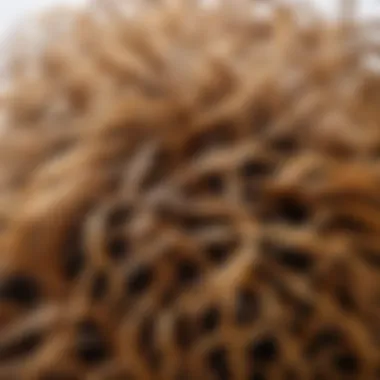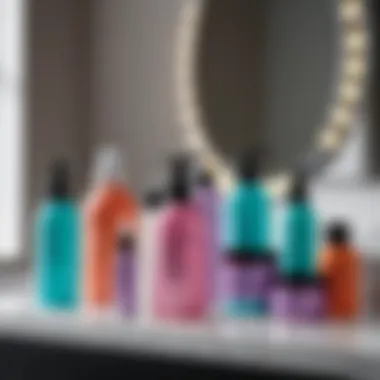Effective Strategies to Tackle Hair Static at Home


Intro
Hair static is a common issue that many face, yet few understand its underlying causes. This phenomenon is primarily the result of an imbalance of electrons on the hair's surface, which can be exacerbated by various environmental factors. Learning to effectively manage hair static not only improves the appearance of hair but also enhances its overall health and manageability.
Understanding how to combat hair static is particularly relevant for individuals who live in dry climates or experience significant seasonal changes. Moreover, the self-care aspect involved in hair management is crucial, as it empowers individuals to maintain their desired look with ease and confidence. Armed with effective strategies, remedies, and product suggestions, this guide aims to equip readers with the necessary tools to tackle hair static from the comfort of home.
Ürün İncelemesi
Ürün Tanıtımı
Many products on the market are designed to help manage hair static. These vary from leave-in conditioners to anti-static sprays that can provide an immediate solution. One standout product is the Moroccanoil Treatment. It is renowned for its nourishing properties and is effective in smoothing frizz while reducing static.
Ürün Özellikleri
The Moroccanoil Treatment boasts several key features:
- Argan Oil: Rich in fatty acids, this oil hydrates and adds shine.
- Quick Absorption: It penetrates the hair quickly, leaving no greasy residue.
- Versatility: Suitable for all hair types and can be used on dry or damp hair.
Users often report significant improvement in hair texture and manageability after incorporating this product into their routine. It effectively reduces flyaways and enhances overall hair health.
Güzellik İpuçları
Doğal Güzellik Yöntemleri
In addition to products, natural remedies can also play a vital role in combating hair static. Here are a few methods:
- Coconut Oil: Applying a small amount can moisturize and reduce static.
- Aloe Vera Gel: This natural gel helps to smooth hair and prevent frizz.
- Humidifiers: Using a humidifier in your home can add moisture to the air, helping to reduce static.
Sağlıklı Beslenme ve Güzellik
Diet cannot be overlooked when discussing hair health. Consuming a balanced diet rich in vitamins and nutrients is essential for maintaining healthy hair. Key nutrients include:
- Omega-3 Fatty Acids: Found in fish, flaxseeds, and walnuts, they nourish hair follicles.
- Biotin: Present in eggs and nuts, biotin supports hair growth.
- Hydration: Drinking enough water aids in keeping hair hydrated from within.
"Healthy hair begins with healthy habits. Your diet directly impacts the condition of your hair."
Managing hair static may seem daunting, but with the right knowledge and tools, it can become a seamless part of your grooming routine. By understanding the causes and implementing effective solutions, anyone can achieve smoother, more manageable hair at home.
Understanding Hair Static
Hair static is a common issue that affects everyone at some point, yet many do not fully understand its underlying causes and how to manage it effectively. Within this context, it is crucial to grasp the science behind hair static, as this knowledge directly influences your ability to control and reduce it. Understanding hair static is not merely about taming flyaway strands; it is also about taking the necessary steps toward better hair health and overall appearance.
What Causes Hair Static?
Hair static is primarily caused by an imbalance of electric charges on the surface of hair strands. When two surfaces rub against each other, electrons can transfer, leading to a buildup of static electricity. Generally, this tends to occur in dry conditions or when the hair is subjected to friction from clothing, brushes, or even other hair strands. Further, natural hair characteristics play a significant role; finer or damaged hair is more prone to static issues. Additionally, the use of certain hair products can either exacerbate or alleviate the problem.
The Role of Humidity
Humidity is a critical factor in managing hair static. In high-humidity environments, hair absorbs moisture, which can help neutralize static charges. Conversely, low humidity can cause hair to lose its moisture, making it more susceptible to static. During dry seasons or in climate-controlled indoor spaces, static becomes particularly noticeable. Therefore, incorporating humidity-promoting practices and products can aid significantly in reducing static electricity buildup in hair, leading to a much smoother appearance.


Static Electricity and Hair Structure
The structure of your hair also determines its susceptibility to static. Each hair strand is made up of layers, including the cuticle, cortex, and medulla. The health and integrity of these layers can influence how hair interacts with static. For instance, damaged cuticles may create a rough surface that is more likely to attract static. Healthy hair, with a smooth cuticle layer, tends to resist static buildup effectively. Understanding these structural elements can guide your choice of products and care routines to best combat static.
Home Remedies for Hair Static
Managing hair static can be challenging, especially in dry or humid conditions. Home remedies provide accessible solutions to mitigate this common issue. They can be effective alternatives to commercial products, often at a lower cost. Utilizing natural ingredients not only reduces static but also contributes to overall hair health. This section explores some of the best home remedies involving natural oils, moisturizing techniques, and hydrating sprays that anyone can incorporate into their hair care routine.
Use of Natural Oils
Natural oils have proven to be effective in reducing hair static. They serve to add moisture and nourishment, which helps combat dryness that often causes static. Each oil possesses unique characteristics that make them suitable for various hair types and concerns.
Argan Oil
Argan oil is known for its rich composition of fatty acids and vitamin E. These nutrients help to hydrate and soften hair, reducing static effectively. This oil penetrates hair strands, providing deep moisture while also offering shine. The lightweight texture of argan oil prevents hair from feeling greasy, making it a popular choice among users. However, it is worth noting that excessive use can weigh hair down, so moderation is key.
Coconut Oil
Coconut oil stands out for its ability to deeply condition hair. It contains lauric acid, which has a high affinity for hair proteins, helping to reduce protein loss. This characteristic stabilizes hair's internal moisture levels and minimizes static. Many choose coconut oil for its widespread availability and affordability. Despite its benefits, some may find it heavy, especially those with fine hair, leading to potential buildup if not washed out properly.
Jojoba Oil
Jojoba oil closely resembles the natural oils produced by our scalp. This similarity allows it to hydrate effectively without leaving a heavy residue. It provides a balance of moisture and is suitable for various hair types. Because of its light texture, jojoba oil is less likely to cause buildup compared to heavier oils. However, it may require regular application to maintain the anti-static benefits.
Moisturizing Techniques
Moisturizing techniques are essential for managing hair static. Keeping hair adequately moisturized not only reduces static but also promotes overall hair health. Here are a couple of effective techniques:
Deep Conditioning
Deep conditioning treatments introduce significant moisture into the hair shaft. This process helps to repair damage and can lead to a reduction in static. Regular deep conditioning is beneficial, especially for dry or curly hair types, enhancing gloss and elasticity. Users often notice improved manageability and less frizz. However, excessive reliance on deep conditioners may lead to greasy hair if not properly managed.
Leave-in Conditioners
Leave-in conditioners provide ongoing hydration throughout the day. They are easy to apply and consistently deliver moisture without the need for rinsing. These products often contain ingredients that control static and frizz, keeping hair smooth and tangle-free. While they offer many advantages, individuals must choose formulations that suit their hair type to avoid weighing hair down.
Hydrating Sprays
Hydrating sprays can provide quick relief from static hair throughout the day. They work by delivering moisture directly to the hair without the heaviness associated with oils or creams. These sprays often feature a mix of nourishing ingredients that protect the hair from environmental stressors. Simple homemade versions can also be created using water, with or without the addition of natural oils. This flexibility allows for individual customization based on personal preferences. Overall, incorporating these hydrating options allows one to better manage hair static in a practical manner.
Using home remedies for hair static can be a sustainable and cost-effective alternative to commercial products. Incorporating natural oils, effective moisturizing techniques, and hydrating sprays can enhance hair health while managing static effectively.
Prevention Strategies
Preventing hair static is crucial, especially for those who strive for smooth and manageable hair. Instead of merely addressing the symptoms of static, implementing effective prevention strategies can significantly reduce its occurrence. A proactive approach allows individuals to maintain healthier hair while minimizing frizz and flyaways. Understanding and applying these strategies leads to long-term benefits and enhances overall hair health.
Choosing the Right Hair Products
Shampoos


Choosing the right shampoo is a foundational step in controlling hair static. The key characteristic to look for in shampoos is their moisturizing ability. Products that provide hydration help combat dryness, which is a major contributor to static. Shampoos containing ingredients like glycerin or shea butter can be particularly beneficial. These ingredients attract moisture, thereby maintaining the hair’s natural moisture balance. However, be cautious with shampoos that contain sulfates, as they may strip the hair of essential oils, which can worsen static issues.
Conditioners
Conditioners play an integral role in managing hair static as well. A good conditioner works to smooth the hair cuticle, which reduces friction and static. Look for conditioners that offer deep hydration and contain ingredients like silicones, which help to seal moisture and create a protective layer on the hair. Using conditioner regularly strengthens hair, making it less prone to static. However, some conditioners can weigh hair down if applied too liberally, so finding the right balance is key.
Styling Products
Styling products are another essential consideration when dealing with hair static. These products can help to lock in moisture and provide a protective barrier for your hair. A leave-in conditioner or anti-static serum can be particularly effective. The unique feature of these products is their ability to create a smooth surface for the hair. This reduces the friction that causes static. While some styling products are heavy and may leave hair feeling greasy, choosing lightweight options can deliver the smoothing benefits without added weight.
Avoiding Heat Damage
Heat damage is a major factor that contributes to hair static. When hair is exposed to high temperatures frequently, it can become dry and brittle, leading to static. It is essential to limit the use of heat styling tools whenever possible. If you must use them, always apply a heat protectant spray beforehand. This helps to shield the hair from the damaging effects of heat. Additionally, try to lower the temperature settings on styling tools to minimize damage overall.
Importance of a Humidifier
A humidifier can be an effective tool in preventing hair static, especially during dry winter months. This device adds moisture to the air, which can significantly improve the hydration levels of both the hair and skin. By maintaining a humid environment, you help reduce the dryness that leads to static. Regularly using a humidifier can be a simple yet highly effective strategy for those who struggle with static hair. It is particularly helpful in regions with low humidity, where static issues tend to escalate.
Styling Techniques to Reduce Static
Managing hair static goes beyond just applying products. The technique one uses to style hair plays a crucial role in static reduction. Selecting the right methods and tools helps not only in minimizing static but also in maintaining the overall health of hair. Specific elements, benefits, and considerations about styling techniques can transform the hair care routine.
When choosing styling methods, consider both the materials used and the technique applied. Each of these can either contribute to or mitigate hair static. Understanding this can lead to smoother, more manageable hair.
Brush Selection
The type of brush used can significantly affect hair static. A brush with natural bristles, such as boar bristle, helps distribute oils from the scalp throughout the hair. This distribution can reduce the likelihood of static buildup. In contrast, plastic or nylon brushes can create friction and increase static. For those who notice excessive static in their hair, it may be worth investing in a high-quality brush with natural fibers.
It’s essential to keep your brushes clean as well. Product buildup on brushes can lead to more friction during styling. Regular cleaning helps to keep both the brush and hair in good condition.
Drying Methods
There are distinct methods of drying that can impact hair static. Understanding these techniques is vital for managing hair effectively.
Air Drying
Air drying is a gentle method for drying hair and is favored for its minimal heat exposure. This technique allows hair to dry naturally, reducing the chances of heat damage from tools like blow dryers. The key characteristic of air drying is its ability to leave hair looking healthy and less frizzy. It is popular amongst individuals who prefer low-maintenance hair care methods.
However, timing is important. Air drying may take longer compared to using a hairdryer. For those with thick hair, this method might be less practical in colder months.
Using a T-shirt
Using a T-shirt instead of a traditional towel is another technique to consider. This method helps reduce frizz and static because the fabric is gentler on hair. The key characteristic here is the softness of the T-shirt, which prevents hair cuticles from becoming raised. This prevents tangling and keeps hair smoother.
It is also a beneficial option because it absorbs excess moisture without the harsh friction caused by a standard towel. However, one downside might be that a T-shirt may not absorb as much water as a towel does, potentially prolonging drying time.
Choosing the Right Hair Tie
The type of hair tie one uses can greatly affect static levels. Elastic hair ties often generate friction, leading to more static. Instead, consider using fabric-covered elastics or hair ties made from satin. These materials provide a gentler hold that minimizes static and keeps hair healthier.


In summary, styling techniques like proper brush selection, drying methods, and choosing the right hair ties are essential for reducing static. Implementing these practices can significantly enhance hair manageability and overall health.
Product Recommendations for Static Reduction
Managing hair static requires more than just home remedies and styling techniques. The right products play an essential role in controlling and reducing static in hair. Effective products can provide immediate relief from annoying flyaways and ensure hair remains manageable throughout the day. It is crucial to select products that align well with your hair type and specific needs.
Anti-static Hair Sprays
Anti-static hair sprays are specially formulated to reduce static and maintain a smooth finish. They typically contain ingredients that help to weigh down the hair slightly, counteracting the buildup of static electricity. These sprays can be applied on dry or damp hair and are designed to offer both protection and a polished look. When choosing an anti-static spray, look for products that claim to provide frizz control and moisture retention.
"A quality anti-static spray can act like a shield against the elements, keeping your hair looking its best even in challenging weather conditions."
Smoothing Serums
Smoothing serums add moisture and shine to hair while combating static. The viscosity of these serums allows them to coat each strand, effectively reducing friction and preventing static buildup. Most smoothing serums contain silicones or natural oils, which can enhance the hair's overall health and appearance. Apply a small amount to the ends of your hair after drying or styling, avoiding the roots to prevent greasiness. Picking a serum based on your hair type ensures optimal results, as some are tailored for finer hair, while others work better on thick, curly locks.
Finished Hair Products with Static Control
Finished hair products, such as pomades, waxes, and creams, can provide a final touch of control in your styling process. These products not only help manage static but also allow for versatile styling options. They can hold styles in place while adding necessary moisture and texture. It is essential to select products that do not leave a heavy residue or build-up on the hair, as this can exacerbate static over time.
Utilizing a combination of these products enhances your overall static management strategy. Understanding your hair's unique characteristics and how different products interact with it can significantly improve outcomes. Always test new products in small amounts to assess their effect and avoid unwanted results.
Additional Considerations and Tips
Managing hair static is not solely about immediate remedies; it involves broader considerations that play a crucial role in overall hair health. Understanding these additional factors can lead to more effective solutions and sustainable hair management strategies.
Seasonal Influences on Hair Static
Changes in seasons can significantly affect how static builds up in your hair. In winter, the air is dry, and indoor heating further reduces moisture levels, leading to increased static. Conversely, summer tends to offer higher humidity which can minimize static to some extent. During these months, adapting your hair care routine becomes necessary.
When the air is dry, incorporate more moisturizing agents into your routine. Products with hydrating ingredients like hyaluronic acid or glycerin help retain moisture. Consider using a humidifier indoors, especially during winter months, as it can increase moisture in the air and benefit your hair health.
- Winter Strategies:
- Summer Strategies:
- Use heavier conditioners and masks.
- Opt for oil-based serums.
- Light leave-in conditioners.
- Regular hydration routines.
Effects of Hair Color Treatments
Coloring treatments have the potential to alter the structure and moisture levels of your hair, making it more susceptible to static. Chemical processes can strip away natural oils, resulting in dryness. This dryness can lead to increased friction and build-up of static.
If you regularly apply hair dyes, make certain that you use specialized products designed for colored hair. These products often contain ingredients that help restore moisture and balance, reducing the risk of static. Additionally, regular deep conditioning treatments can help manage this issue effectively.
- Color Treatment Care Tips:
- Look for sulfate-free shampoos.
- Use bond-building conditioners.
Consulting a Professional
In certain circumstances, managing hair static may require consulting a professional hairstylist. A stylist can provide personalized recommendations based on your hair type, color history, and environmental exposure. While many solutions are accessible at home, professional advice can lead to tailored treatment plans.
If static becomes a persistent issue, a professional may suggest specific hair care products or techniques that are most effective for your unique situation. Additionally, they can help identify any underlying issues related to hair health or damage that may be contributing to the problem.
"A professional perspective can illuminate potential practices and products that you might not consider on your own."
By acknowledging these additional considerations, you foster a more comprehensive understanding of hair static management. This can lead not only to immediate relief but also to long-term strategies for maintaining healthy, manageable hair.







